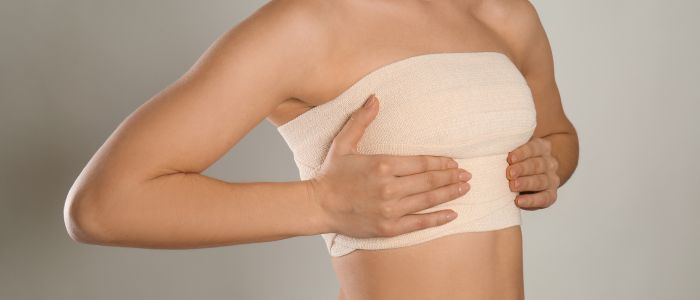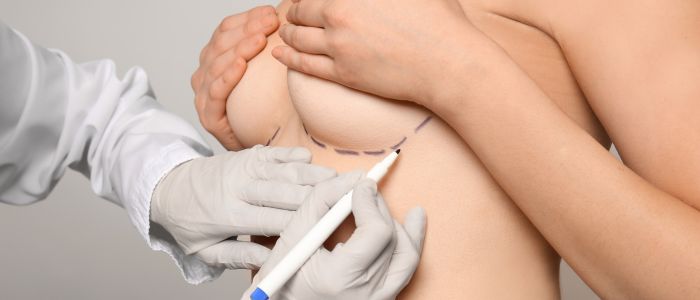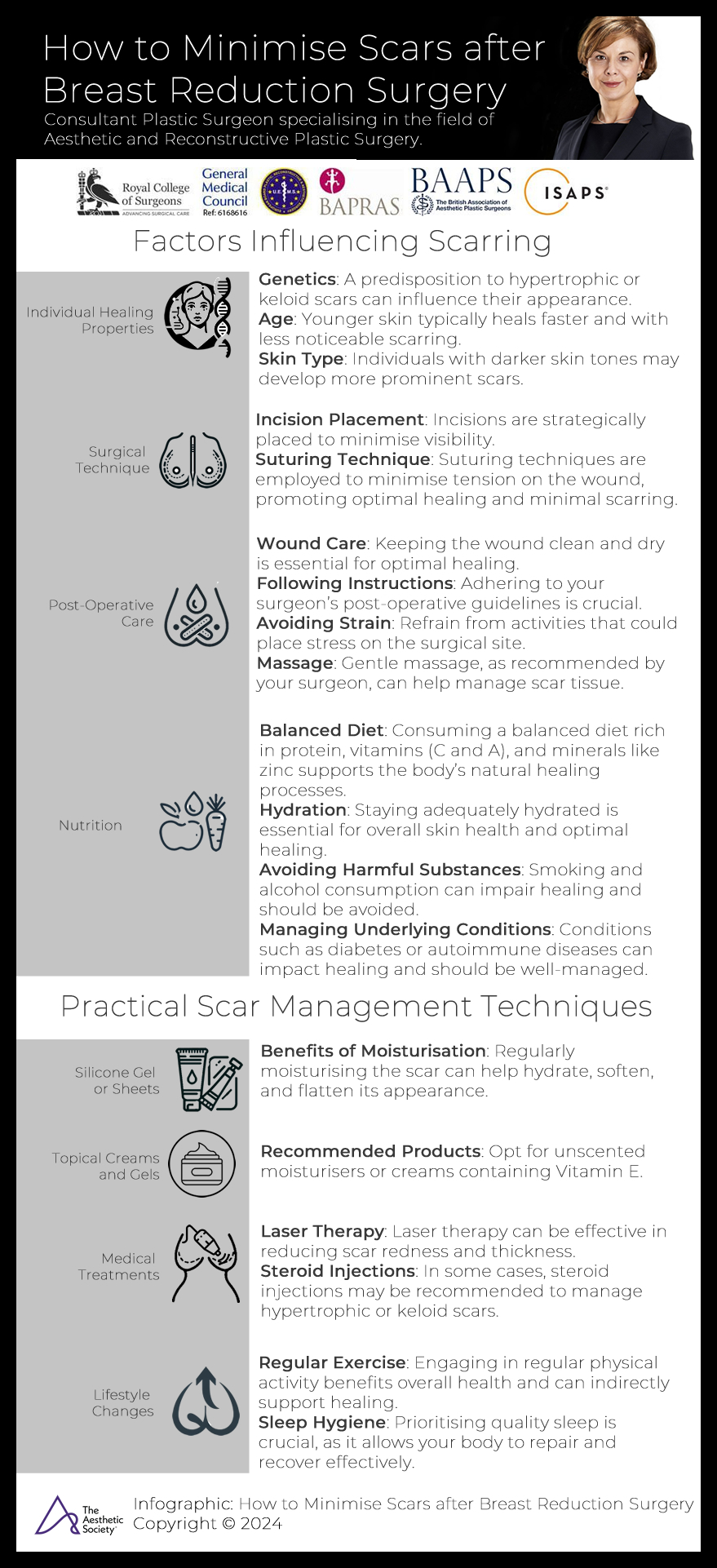
- Scar Management after Breast Reduction Surgery
- Take our Plastic Surgery Quiz to find out if you'd be a good candidate for cosmetic surgery.
- What Is Breast Reduction Surgery?
- Scars after Breast Reduction Surgery
- Techniques to Reduce Scars after Breast Reduction Surgery
- Download Miss Anca Breahna’s Scar Revision Guide
- Post-Surgery Care for Minimal Scarring
- FAQs about Scars after Breast Reduction Surgery
- Latest Research about Scar Management
- Further Reading about Breast Surgery with Consultant Plastic Surgeon Anca Breahna
Scar Management after Breast Reduction Surgery
Reducing scars after breast reduction surgery is a topic of significant interest for many patients undergoing this procedure. Scars, while a natural consequence of such surgeries, can often lead to discomfort or self-consciousness. This blog aims to address these concerns by providing an in-depth understanding of the surgical procedure, the nature of scarring, and effective techniques to manage and minimise scars post breast reduction surgery.
The guide draws upon the expertise of Consultant Plastic Surgeon Anca Breahna, a distinguished plastic surgeon based in Chester, UK, who specialises in breast reduction surgery. Her insights and professional experience offer a valuable perspective on the subject matter.
This guide is intended for those interested in breast reduction surgery, those who have recently undergone the procedure, or those supporting a loved one through their journey. By offering practical advice and answering common questions, it seeks to give readers the knowledge necessary to navigate their post-surgery journey with confidence.
Take our Plastic Surgery Quiz to find out if you’d be a good candidate for cosmetic surgery.
What Is Breast Reduction Surgery?
Breast reduction surgery, medically known as reduction mammoplasty, is a procedure designed to alleviate the discomfort associated with overly large breasts. The surgery involves the removal of excess breast fat, glandular tissue, and skin to achieve a breast size in proportion with the patient’s body.
The procedure begins with your plastic surgeon making incisions on the breasts. The pattern of these incisions depends on the amount of tissue to be removed, the patient’s personal conditions, and the surgeon’s best judgement. After the incisions, the nipple—which remains tethered to its original blood and nerve supply is repositioned. If necessary, the areola is reduced by excising skin at the perimeter. Underlying breast tissue is then reduced, lifted, and shaped.
Following the surgery, stitches are layered deep within the breast tissue to create and support the newly shaped breasts. Stitches, skin adhesives, or surgical tape may be used to close the skin.
The results of breast reduction surgery will be immediately visible. Over time, post-surgical swelling will resolve and incision lines will fade. Satisfaction with your new image should continue to grow as you recover and realise the benefits of this life-enhancing procedure.
Scars after Breast Reduction Surgery
Scarring is a natural and inevitable part of the healing process following any surgical procedure, including breast reduction. The extent and visibility of these scars can vary based on several factors such as the surgical technique used, individual healing process, and post-operative care.
In breast reduction surgery, incisions are usually made in one of three patterns: around the areola; around the areola and vertically down from the areola to the breast crease; or an inverted T or anchor-shaped incision pattern. Consequently, scars are usually located around the darker skin surrounding the nipple (areola), extending vertically down to the breast crease and horizontally along the crease.
Immediately after surgery, these scars can be quite noticeable. But over time they tend to fade and become less visible. The final appearance of the scar can take up to a year or more to fully establish. It’s important to note that while scars become less obvious over time, they are permanent and complete scar disappearance is not possible.
Individual factors such as genetics, age, skin type, and lifestyle can also influence scar healing and appearance. For instance, younger skin tends to heal faster and better than older skin, and non-smokers generally heal better than smokers.
Techniques to Reduce Scars after Breast Reduction Surgery
Minimising the appearance of scars following breast reduction surgery is a multi-faceted process that can involve a variety of techniques. Here, we delve deeper into each of these methods:
- Surgical Technique: The first step in minimising scarring begins in the operating room. A skilled surgeon will employ techniques that place incisions in less visible areas or follow the natural contours of the body to make scars less noticeable. For instance, incisions can be made around the areola or along the breast crease where the natural shadows of the body can help conceal the scars
- Scar Management Therapies: Once the surgical wounds have healed, scar management therapies can be initiated. Silicone sheets or gels are commonly used and have been shown to reduce the thickness and visibility of scars. They work by hydrating the scar tissue, which helps to soften and flatten the scars, and reduce associated symptoms such as itching and discomfort
- Laser Therapy: Laser therapy can be an effective method for scar reduction. Different types of lasers can target various aspects of the scar. For example, pulsed dye lasers can improve redness, while fractional lasers can help smooth out the texture and reduce the thickness of scars
- Steroid Injections: Steroid injections can be used to treat hypertrophic or keloid scars, which are raised, thickened areas of scarring. The steroids work by reducing inflammation and slowing down the rapid cell growth that leads to such scars. This can help to flatten and soften the scar, making it less noticeable
- Microneedling: Microneedling is a procedure that uses small needles to prick the skin and stimulate new collagen production, which can help to reduce the appearance of scars. The new collagen helps to fill in the scar tissue, making it more level with the rest of the skin. This treatment can also improve the texture and colour of the scar
- Topical Treatments: There are numerous creams, oils, and gels available that can help to reduce the appearance of scars. These often contain ingredients like onion extract or vitamin E, which have been shown to improve the colour, texture, and overall appearance of scars. It’s important to note that these treatments are usually more effective on newer scars and may not have as much effect on older, more established scars
Download Miss Anca Breahna’s Scar Revision Guide

Post-Surgery Care for Minimal Scarring
Post-operative care plays a crucial role in the healing process and the eventual appearance of scars. Here are some strategies that can help minimise scarring after breast reduction surgery:
- Follow Your Plastic Surgeon’s Instructions: After surgery, your plastic surgeon will provide detailed instructions on how to care for your incisions. This may include cleaning protocols and application of topical treatments. Adhering to these instructions is vital for optimal healing and scar minimisation
- Avoid Sun Exposure: Ultraviolet (UV) rays can darken scars and make them more noticeable. It’s recommended to keep your scars covered and apply a high-factor sunscreen if you need to be in the sun
- Maintain a Healthy Lifestyle: Good nutrition, adequate hydration, and regular exercise (once approved by your plastic surgeon) can promote better healing. Avoid smoking and excessive alcohol consumption as these can impair the healing process
- Wear Appropriate Support Garments: Your plastic surgeon will likely recommend a specific type of bra to wear after surgery. These garments provide necessary support, reduce movement, and help minimise tension on the incisions, which can lead to wider scars
- Gentle Massage: Once the incisions have fully healed, gentle massage can help to soften and flatten scars. It also improves circulation in the area, promoting healing and reducing scar visibility
- Patience and Time: Healing is a gradual process, and scars improve over time. It can take up to a year or more for scars to mature and fade to their final appearance
FAQs about Scars after Breast Reduction Surgery
Will the scars from my breast reduction surgery ever completely disappear?
While scars from breast reduction surgery will significantly fade over time, they will not completely disappear. The degree to which they fade depends on several factors, including your genetics, age, skin type, and the specific surgical technique used.
What can I do to help my scars heal better after surgery?
Post-operative care is crucial for optimal scar healing. This includes following your plastic surgeon’s instructions for wound care, avoiding sun exposure, maintaining a healthy lifestyle, wearing appropriate support garments, and possibly massaging the area once fully healed.
Can I use over-the-counter scar creams to reduce my scars?
Over-the-counter scar creams can help to some extent, but their effectiveness varies. They are usually more effective on newer scars. It’s always best to discuss this with your plastic surgeon before starting any new treatment.
What should I do if my scar becomes red, raised, or itchy?
If your scar becomes red, raised, or itchy, it could be a sign of abnormal scar formation, such as hypertrophic scarring or keloids, or a sign of infection. You should contact your plastic surgeon’s team as soon as possible to have it evaluated.
Can I undergo another procedure to remove or improve the appearance of my scars?
Yes, there are several procedures that can improve the appearance of scars, including laser therapy, microneedling, and surgical scar revision. These should only be considered once the scar has fully matured, which can take up to a year or more. You ca schedule a consultation with your plastic surgeon to discuss scar minimisation options.
Medical References
- “Breast Reduction Scars: Healing, Appearance & Treatment.” Cleveland Clinic. –
https://my.clevelandclinic.org/health/treatments/24782-breast-reduction-scars
- “What to know about scars after breast reduction surgery.” Medical News Today. –
https://www.medicalnewstoday.com/articles/breast-reduction-scars
- “Breast reduction surgery.” Mayo Clinic. –
https://www.mayoclinic.org/tests-procedures/breast-reduction-surgery/about/pac-20385246
- “Breast Reduction.” American Society of Plastic Surgeons. –
https://www.plasticsurgery.org/reconstructive-procedures/breast-reduction
- “Breast reduction (female).” NHS. –
https://www.nhs.uk/conditions/cosmetic-procedures/cosmetic-surgery/breast-reduction-female/
Latest Research about Scar Management
Recent advancements and studies have contributed significantly to our understanding of scar reduction techniques. Here are a few notable findings:
- A study titled “Evidence-Based Scar Management: How to Improve Results with Technique and Technology” discusses various products marketed for scar prevention or improvement and their efficacy based on high-level studies.
- The use of silicone gel sheeting for preventing and treating hypertrophic and keloid scars has been explored in a Cochrane review. The review found that silicone gel sheeting produced a significant reduction in scar thickness and colour amelioration.
- A 12-week prospective, double-blind, randomized, split-face study investigated the combination treatment with human adipose tissue stem cell-derived exosomes and fractional CO2 laser for acne scars. The study found significant improvement in the treated sides.
- A meta-analysis and systematic review compared vertical scar versus inverted-T scar reduction mammaplasty, providing valuable insights into these two techniques.
- An article titled “Alternative techniques for reduction of scar length during staged excision” describes alternatives to the conventional staged excision that enable further reduction in final scar length.
These studies underscore the ongoing efforts in the medical community to improve scar reduction techniques and outcomes for patients.
Further Reading about Breast Surgery with Consultant Plastic Surgeon Anca Breahna
- Read more about Breast Uplift – Mastopexy
- Read more about Breast Implant Removal And Uplift
- Read Miss Anca Breahna’s Blog on Private Breast Reduction Surgery in the UK
- Read Miss Anca Breahna’s Blog on Breast Reduction for Adolescents and Young Women
- Read Miss Anca Breahna’s Blog on Treating, Reducing and Minimising Plastic Surgery Scars
- Read Miss Anca Breahna’s Blog on Breast Reduction Surgery and Age: Considerations for Different Life Stages
- Read Miss Anca Breahna’s Blog on How to Choose the Right Size for Breast Reduction



 Ms Anca Breahna, PhD, MSc, FEBOPRAS, FRCS (Plast) is a highly regarded Consultant Plastic Surgeon specialising in the field of Aesthetic and Reconstructive Plastic Surgery. Anca performs a range of
Ms Anca Breahna, PhD, MSc, FEBOPRAS, FRCS (Plast) is a highly regarded Consultant Plastic Surgeon specialising in the field of Aesthetic and Reconstructive Plastic Surgery. Anca performs a range of 